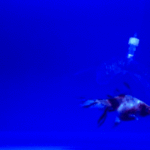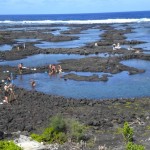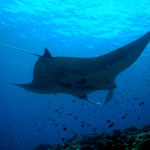
In an alarming trend, the practice of “dynamite” or “bomb” fishing has spread recently to Central America. Reports are coming in that hawksbill turtles are being blasted to death by explosive fishermen working in the Biosphere Reserve of the Bahia de Jiquilisco, El Salvador. At least seven turtles have been found dead, according to Michael Liles, Sea Turtle Conservation Project Coordinator for Fundacion Zoologica de El Salvador (FUNZEL).
The use of explosives is exterminating all species of larvae, juvenile and adult fish, as well as crustaceous, mollusks, sea turtles, and other species of organism living throughout the Bahia de Jiquilisco.
The practice spread from Southeast Asia, where dynamite fishing is common. The blast leaves a crater on the saeabed, and stuns the fish, which are then collected by nets. Corals and turtles are irreparably damaged in the process. This technique (and others) were outlawed in the Philippines in 1986. However, the practice is difficult to enforce and control, because fishermen make their own explosives in bottles filled with fertilizer and alcohol.
J Nichols is asking for your help to spread the word about these regrettable and indescriminate killings. He says “Local government, NGO and university support is strong,” but they could use our help raising awareness about the issue. “We are promoting turtle watching as an alternative… once the bomb fishing is under control.”
Michael Liles’ eyewitness account of the sea turtle destruction and bombing of the biosphere reserve at Bahia de Jiquilisco is pasted below in a letter to local authorities.
To Whom It May Concern:
I would like to bring to your attention the following matter related to the use of explosives as a local fishing technique in the Biosphere Reserve of the Bahia de Jiquilisco, El Salvador.
From May 15th to May 18th, 2008, I accompanied Neil Osborne, a professional freelance photographer from the United States, to the island of San Sebastian, which is located in the Bahia de Jiquilisco. His mission was to document the nesting of the hawksbill turtle and to promote ecotourism in the region. Mr. Osborne is currently working on the “SEE Turtles” project of the Ocean Conservancy and has published his work in several prestigious travel magazines.
During the second day of our visit, around 10:00 AM, Mr. Osborne and I were swimming in front of the tourist complex of the Island when a group of artisanal fishermen threw an explosive about 30 meters in front of us. We were so shocked and startled, that the photographer wanted to leave the island immediately and return to the capital, fearing something could happen to him.
Mr. Osborne was here in El Salvador to promote ecotourism in the country but seeing what was happening in the Bahia de Jiquilisco, he was ready to pack up his things and head home.
During recent conversations with Mauricio Vasquez Jandres from the Marines Sciences Institute of the University of El Salvador (ICMARES), he mentioned that the use of explosives as a fishing technique has increased in the entire region of the Bahia in the last eight years, and there are approximately 25 local fishermen that use this practice daily. The use of explosives is exterminating all species of larvae, juvenile and adult fish, as well as crustaceous, mollusks, sea turtles, and other species of organism living throughout the Bahia de Jiquilisco.
From January 2008 to the present, seven adult hawksbill turtles have been killed by this practice. The hawksbill in the picture died from on of these explosives; it is clear evidence of the harm that this technique is generating and it is extremely unfortunate that one single bomb can reverse all efforts to promote tourism and conservation for the country.
Sincerely,
Michael Liles
Sea Turtle Conservation Project Coordinator
Fundacion Zoologica de El Salvador (FUNZEL)
I’ve seen the night sky lit up by these explosions in the Sulu Sea, and witnessed the destruction of these reefs first hand. The scientist in me said “nice recruitment experiment”, but the human face of the problem touched me very, very deeply. That expedition (with WWF) brought me face-to-face with the lasting irony that the world’s most diverse coral reef habitats are under the stewardship of some of the poorest, most desperate people in the world. Ask me to tell you about it sometime.






this is heinous
this is illegal
this will cease
Thank you Peter for this article! So far this year (January-July 2008), eight adult Hawksbills have been killed by explosives in the Bahia de Jiquilisco, which houses El Salvador’s primary nesting beaches for this critically endangered species (and which also happens to be, ironically, a Biosphere Reserve). Hopefully with international support like this, and with local pressure being applied here in El Salvador, this issue will be taken seriously and made a priority by the Salvadorian government.
What’s next … cyanide?
Ever heard of muro-ami? An ecological AND a social problem.
Enslaves SE Asian kids and puts them out to sea for 9 months.
Didn’t know about that one. Very nasty! How prevalent is that today?
I am familiar with the similar kayakas “method” done in some areas of the PI in shallow waters (wading depths) hammering on reefs to scare fish into waiting nets. I rather hoped, since I hadn’t heard of it since the late 80’s, that it was no longer practiced. Naive I know…
Sounds very similar. The method is currently in practice. What started as a village activity and a right of passage became poor upland farm kids sold or “leased” into the trade. At least one kid got away, though, and there the story lies.
Heartbreaking: the explosives, yes, but especially the muro-ami. Thanks for bringing this to our attention, Peter.